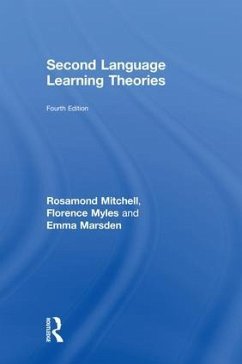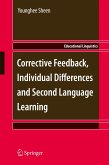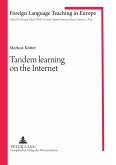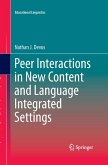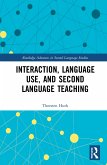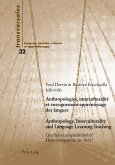- Gebundenes Buch
- Merkliste
- Auf die Merkliste
- Bewerten Bewerten
- Teilen
- Produkt teilen
- Produkterinnerung
- Produkterinnerung
Written by a team of leading experts working in different SLA specialisms, this fourth edition of Second Language Learning Theories a clear and concise introduction to the main theories of second language acquisition (SLA) from multiple perspectives, comprehensively updated to reflect the very latest developments SLA research.
Andere Kunden interessierten sich auch für
![Corrective Feedback, Individual Differences and Second Language Learning Corrective Feedback, Individual Differences and Second Language Learning]() Younghee SheenCorrective Feedback, Individual Differences and Second Language Learning116,99 €
Younghee SheenCorrective Feedback, Individual Differences and Second Language Learning116,99 €![Tandem learning on the Internet Tandem learning on the Internet]() Markus KötterTandem learning on the Internet94,35 €
Markus KötterTandem learning on the Internet94,35 €![Peer Interactions in New Content and Language Integrated Settings Peer Interactions in New Content and Language Integrated Settings]() Nathan J. DevosPeer Interactions in New Content and Language Integrated Settings39,99 €
Nathan J. DevosPeer Interactions in New Content and Language Integrated Settings39,99 €![Interaction, Language Use, and Second Language Teaching Interaction, Language Use, and Second Language Teaching]() Thorsten HuthInteraction, Language Use, and Second Language Teaching198,99 €
Thorsten HuthInteraction, Language Use, and Second Language Teaching198,99 €![Reconceptualizing English Education in a Multilingual Society Reconceptualizing English Education in a Multilingual Society]() Reconceptualizing English Education in a Multilingual Society77,99 €
Reconceptualizing English Education in a Multilingual Society77,99 €![Anthropologies, interculturalité et enseignement-apprentissage des langues- Anthropology, Interculturality and Language Learning-Teaching Anthropologies, interculturalité et enseignement-apprentissage des langues- Anthropology, Interculturality and Language Learning-Teaching]() Anthropologies, interculturalité et enseignement-apprentissage des langues- Anthropology, Interculturality and Language Learning-Teaching56,55 €
Anthropologies, interculturalité et enseignement-apprentissage des langues- Anthropology, Interculturality and Language Learning-Teaching56,55 €![Reconceptualizing English Education in a Multilingual Society Reconceptualizing English Education in a Multilingual Society]() Reconceptualizing English Education in a Multilingual Society77,99 €
Reconceptualizing English Education in a Multilingual Society77,99 €-
-
-
Written by a team of leading experts working in different SLA specialisms, this fourth edition of Second Language Learning Theories a clear and concise introduction to the main theories of second language acquisition (SLA) from multiple perspectives, comprehensively updated to reflect the very latest developments SLA research.
Hinweis: Dieser Artikel kann nur an eine deutsche Lieferadresse ausgeliefert werden.
Hinweis: Dieser Artikel kann nur an eine deutsche Lieferadresse ausgeliefert werden.
Produktdetails
- Produktdetails
- Verlag: Routledge
- 4. Auflage
- Seitenzahl: 462
- Erscheinungstermin: 21. Januar 2019
- Englisch
- Abmessung: 235mm x 157mm x 29mm
- Gewicht: 815g
- ISBN-13: 9781138671409
- ISBN-10: 1138671401
- Artikelnr.: 55101309
- Herstellerkennzeichnung
- Libri GmbH
- Europaallee 1
- 36244 Bad Hersfeld
- gpsr@libri.de
- Verlag: Routledge
- 4. Auflage
- Seitenzahl: 462
- Erscheinungstermin: 21. Januar 2019
- Englisch
- Abmessung: 235mm x 157mm x 29mm
- Gewicht: 815g
- ISBN-13: 9781138671409
- ISBN-10: 1138671401
- Artikelnr.: 55101309
- Herstellerkennzeichnung
- Libri GmbH
- Europaallee 1
- 36244 Bad Hersfeld
- gpsr@libri.de
Rosamond Mitchell is Emeritus Professor of Applied Linguistics at the University of Southampton, UK. Florence Myles is Professor of Second Language Acquisition at the University of Essex, UK. Emma Marsden is Professor at the Centre for Research into Language Learning and Use at the University of York, UK.
Table of Contents
List of illustrations
Acknowledgements
Preface
1. Second language learning: key concepts and issues
1. Introduction
2. What makes for a good theory?
3. Views on the nature of language
4. The language learning process
5. Views of the language learner
6. Links with social practice
7. Conclusion
8. References
2. The recent history of second language learning research
1. Introduction
2. The 1950s and 1960s
3. The 1970s
4. The 1980s: a turning point
5. Continuities and new themes
6. Second language learning timeline
7. References
3. Linguistics and language learning: the Universal Grammar approach
1. Introduction
2. Why a Universal Grammar?
3. What does Universal Grammar consist of?
4. Universal Grammar and L1 acquisition
5. Universal Grammar and L2 acquisition
6. Evaluation of Universal Grammar-based approaches to L2 acquisition
7. References
4. Cognitive approaches to second language learning (1): general learning
mechanisms
1. Introduction
2. Input-based emergentist perspectives
3. Processing-based perspectives
4. Evaluation of general cognitive approaches
5. References
5. Cognitive approaches to second language learning (2): Memory systems,
explicit knowledge, and skill learning
1. Introduction
2. Memory systems and their role in L2 learning
3. Explicit knowledge, information processing and skill acquisition
4. Awareness and attention in L2 acquisition
5. Working memory and L2 learning
6. Evaluation of cognitive approaches (2): memory systems, explicit
knowledge, and skill learning
7. References
6. Interaction in second language learning
1. Introduction
2. The revised Interaction Hypothesis (Long, 1996): an appeal to
cognitive theory
3. Negotiation of meaning and the learning of target L2 structures and
vocabulary
4. The role of feedback during oral interaction
5. The problem of "noticing"
6. L2 development in computer-mediated interaction
7. Characteristics of learners and of tasks
8. Evaluation
9. References
7. Meaning-based perspectives on second language learning
1. Introduction
2. Early functionalist studies of second language learning
3. Functionalism beyond the case study: the "learner varieties" approach
4. "Time talk": developing the means to talk about time
5. The Aspect Hypothesis
6. Cognitive linguistics and "thinking for speaking"
7. Second language pragmatics
8. Evaluation
9. References
8. Sociocultural perspectives on second language learning
1. Introduction
2. Sociocultural theory
3. Applications of sociocultural theory to second language learning
4. Evaluation
5. References
9. Sociolinguistic perspectives
1. Introduction
2. Sociolinguistically driven variability in second language use
3. Second language socialization
4. Conversation analysis and second language learning
5. Communities of practice and situated learning
6. The language learner as social being: L2 identity, agency and
investment
7. Evaluation: the scope and achievement of sociolinguistic inquiry
8. References
10. Integrating theoretical perspectives on second language learning
10.1. Introduction
10.2. The MOGUL framework
10.3. Dynamic Systems Theory (DST)
10.4. Conclusion
10.5. References
11. Conclusion
1. One theory or many?
2. Main achievements of second language learning research
3. Future directions
4. Second language research and language education
Glossary
Subject index
Name index
List of illustrations
Acknowledgements
Preface
1. Second language learning: key concepts and issues
1. Introduction
2. What makes for a good theory?
3. Views on the nature of language
4. The language learning process
5. Views of the language learner
6. Links with social practice
7. Conclusion
8. References
2. The recent history of second language learning research
1. Introduction
2. The 1950s and 1960s
3. The 1970s
4. The 1980s: a turning point
5. Continuities and new themes
6. Second language learning timeline
7. References
3. Linguistics and language learning: the Universal Grammar approach
1. Introduction
2. Why a Universal Grammar?
3. What does Universal Grammar consist of?
4. Universal Grammar and L1 acquisition
5. Universal Grammar and L2 acquisition
6. Evaluation of Universal Grammar-based approaches to L2 acquisition
7. References
4. Cognitive approaches to second language learning (1): general learning
mechanisms
1. Introduction
2. Input-based emergentist perspectives
3. Processing-based perspectives
4. Evaluation of general cognitive approaches
5. References
5. Cognitive approaches to second language learning (2): Memory systems,
explicit knowledge, and skill learning
1. Introduction
2. Memory systems and their role in L2 learning
3. Explicit knowledge, information processing and skill acquisition
4. Awareness and attention in L2 acquisition
5. Working memory and L2 learning
6. Evaluation of cognitive approaches (2): memory systems, explicit
knowledge, and skill learning
7. References
6. Interaction in second language learning
1. Introduction
2. The revised Interaction Hypothesis (Long, 1996): an appeal to
cognitive theory
3. Negotiation of meaning and the learning of target L2 structures and
vocabulary
4. The role of feedback during oral interaction
5. The problem of "noticing"
6. L2 development in computer-mediated interaction
7. Characteristics of learners and of tasks
8. Evaluation
9. References
7. Meaning-based perspectives on second language learning
1. Introduction
2. Early functionalist studies of second language learning
3. Functionalism beyond the case study: the "learner varieties" approach
4. "Time talk": developing the means to talk about time
5. The Aspect Hypothesis
6. Cognitive linguistics and "thinking for speaking"
7. Second language pragmatics
8. Evaluation
9. References
8. Sociocultural perspectives on second language learning
1. Introduction
2. Sociocultural theory
3. Applications of sociocultural theory to second language learning
4. Evaluation
5. References
9. Sociolinguistic perspectives
1. Introduction
2. Sociolinguistically driven variability in second language use
3. Second language socialization
4. Conversation analysis and second language learning
5. Communities of practice and situated learning
6. The language learner as social being: L2 identity, agency and
investment
7. Evaluation: the scope and achievement of sociolinguistic inquiry
8. References
10. Integrating theoretical perspectives on second language learning
10.1. Introduction
10.2. The MOGUL framework
10.3. Dynamic Systems Theory (DST)
10.4. Conclusion
10.5. References
11. Conclusion
1. One theory or many?
2. Main achievements of second language learning research
3. Future directions
4. Second language research and language education
Glossary
Subject index
Name index
Table of Contents
List of illustrations
Acknowledgements
Preface
Glossary
Subject index
Name index
List of illustrations
Acknowledgements
Preface
- Second language learning: key concepts and issues
- Introduction
- What makes for a good theory?
- Views on the nature of language
- The language learning process
- Views of the language learner
- Links with social practice
- Conclusion
- References
- The recent history of second language learning research
- Introduction
- The 1950s and 1960s
- The 1970s
- The 1980s: a turning point
- Continuities and new themes
- Second language learning timeline
- References
- Linguistics and language learning: the Universal Grammar approach
- Introduction
- Why a Universal Grammar?
- What does Universal Grammar consist of?
- Universal Grammar and L1 acquisition
- Universal Grammar and L2 acquisition
- Evaluation of Universal Grammar-based approaches to L2 acquisition
- References
- Cognitive approaches to second language learning (1): general learning mechanisms
- Introduction
- Input-based emergentist perspectives
- Processing-based perspectives
- Evaluation of general cognitive approaches
- References
- Cognitive approaches to second language learning (2): Memory systems, explicit knowledge, and skill learning
- Introduction
- Memory systems and their role in L2 learning
- Explicit knowledge, information processing and skill acquisition
- Awareness and attention in L2 acquisition
- Working memory and L2 learning
- Evaluation of cognitive approaches (2): memory systems, explicit knowledge, and skill learning
- References
- Interaction in second language learning
- Introduction
- The revised Interaction Hypothesis (Long, 1996): an appeal to cognitive theory
- Negotiation of meaning and the learning of target L2 structures and vocabulary
- The role of feedback during oral interaction
- The problem of "noticing"
- L2 development in computer-mediated interaction
- Characteristics of learners and of tasks
- Evaluation
- References
- Meaning-based perspectives on second language learning
- Introduction
- Early functionalist studies of second language learning
- Functionalism beyond the case study: the "learner varieties" approach
- "Time talk": developing the means to talk about time
- The Aspect Hypothesis
- Cognitive linguistics and "thinking for speaking"
- Second language pragmatics
- Evaluation
- References
- Sociocultural perspectives on second language learning
- Introduction
- Sociocultural theory
- Applications of sociocultural theory to second language learning
- Evaluation
- References
- Sociolinguistic perspectives
- Introduction
- Sociolinguistically driven variability in second language use
- Second language socialization
- Conversation analysis and second language learning
- Communities of practice and situated learning
- The language learner as social being: L2 identity, agency and investment
- Evaluation: the scope and achievement of sociolinguistic inquiry
- References
- Integrating theoretical perspectives on second language learning
- Conclusion
- One theory or many?
- Main achievements of second language learning research
- Future directions
- Second language research and language education
10.1. Introduction
10.2. The MOGUL framework
10.3. Dynamic Systems Theory (DST)
10.4. Conclusion
10.5. References
Glossary
Subject index
Name index
Table of Contents
List of illustrations
Acknowledgements
Preface
1. Second language learning: key concepts and issues
1. Introduction
2. What makes for a good theory?
3. Views on the nature of language
4. The language learning process
5. Views of the language learner
6. Links with social practice
7. Conclusion
8. References
2. The recent history of second language learning research
1. Introduction
2. The 1950s and 1960s
3. The 1970s
4. The 1980s: a turning point
5. Continuities and new themes
6. Second language learning timeline
7. References
3. Linguistics and language learning: the Universal Grammar approach
1. Introduction
2. Why a Universal Grammar?
3. What does Universal Grammar consist of?
4. Universal Grammar and L1 acquisition
5. Universal Grammar and L2 acquisition
6. Evaluation of Universal Grammar-based approaches to L2 acquisition
7. References
4. Cognitive approaches to second language learning (1): general learning
mechanisms
1. Introduction
2. Input-based emergentist perspectives
3. Processing-based perspectives
4. Evaluation of general cognitive approaches
5. References
5. Cognitive approaches to second language learning (2): Memory systems,
explicit knowledge, and skill learning
1. Introduction
2. Memory systems and their role in L2 learning
3. Explicit knowledge, information processing and skill acquisition
4. Awareness and attention in L2 acquisition
5. Working memory and L2 learning
6. Evaluation of cognitive approaches (2): memory systems, explicit
knowledge, and skill learning
7. References
6. Interaction in second language learning
1. Introduction
2. The revised Interaction Hypothesis (Long, 1996): an appeal to
cognitive theory
3. Negotiation of meaning and the learning of target L2 structures and
vocabulary
4. The role of feedback during oral interaction
5. The problem of "noticing"
6. L2 development in computer-mediated interaction
7. Characteristics of learners and of tasks
8. Evaluation
9. References
7. Meaning-based perspectives on second language learning
1. Introduction
2. Early functionalist studies of second language learning
3. Functionalism beyond the case study: the "learner varieties" approach
4. "Time talk": developing the means to talk about time
5. The Aspect Hypothesis
6. Cognitive linguistics and "thinking for speaking"
7. Second language pragmatics
8. Evaluation
9. References
8. Sociocultural perspectives on second language learning
1. Introduction
2. Sociocultural theory
3. Applications of sociocultural theory to second language learning
4. Evaluation
5. References
9. Sociolinguistic perspectives
1. Introduction
2. Sociolinguistically driven variability in second language use
3. Second language socialization
4. Conversation analysis and second language learning
5. Communities of practice and situated learning
6. The language learner as social being: L2 identity, agency and
investment
7. Evaluation: the scope and achievement of sociolinguistic inquiry
8. References
10. Integrating theoretical perspectives on second language learning
10.1. Introduction
10.2. The MOGUL framework
10.3. Dynamic Systems Theory (DST)
10.4. Conclusion
10.5. References
11. Conclusion
1. One theory or many?
2. Main achievements of second language learning research
3. Future directions
4. Second language research and language education
Glossary
Subject index
Name index
List of illustrations
Acknowledgements
Preface
1. Second language learning: key concepts and issues
1. Introduction
2. What makes for a good theory?
3. Views on the nature of language
4. The language learning process
5. Views of the language learner
6. Links with social practice
7. Conclusion
8. References
2. The recent history of second language learning research
1. Introduction
2. The 1950s and 1960s
3. The 1970s
4. The 1980s: a turning point
5. Continuities and new themes
6. Second language learning timeline
7. References
3. Linguistics and language learning: the Universal Grammar approach
1. Introduction
2. Why a Universal Grammar?
3. What does Universal Grammar consist of?
4. Universal Grammar and L1 acquisition
5. Universal Grammar and L2 acquisition
6. Evaluation of Universal Grammar-based approaches to L2 acquisition
7. References
4. Cognitive approaches to second language learning (1): general learning
mechanisms
1. Introduction
2. Input-based emergentist perspectives
3. Processing-based perspectives
4. Evaluation of general cognitive approaches
5. References
5. Cognitive approaches to second language learning (2): Memory systems,
explicit knowledge, and skill learning
1. Introduction
2. Memory systems and their role in L2 learning
3. Explicit knowledge, information processing and skill acquisition
4. Awareness and attention in L2 acquisition
5. Working memory and L2 learning
6. Evaluation of cognitive approaches (2): memory systems, explicit
knowledge, and skill learning
7. References
6. Interaction in second language learning
1. Introduction
2. The revised Interaction Hypothesis (Long, 1996): an appeal to
cognitive theory
3. Negotiation of meaning and the learning of target L2 structures and
vocabulary
4. The role of feedback during oral interaction
5. The problem of "noticing"
6. L2 development in computer-mediated interaction
7. Characteristics of learners and of tasks
8. Evaluation
9. References
7. Meaning-based perspectives on second language learning
1. Introduction
2. Early functionalist studies of second language learning
3. Functionalism beyond the case study: the "learner varieties" approach
4. "Time talk": developing the means to talk about time
5. The Aspect Hypothesis
6. Cognitive linguistics and "thinking for speaking"
7. Second language pragmatics
8. Evaluation
9. References
8. Sociocultural perspectives on second language learning
1. Introduction
2. Sociocultural theory
3. Applications of sociocultural theory to second language learning
4. Evaluation
5. References
9. Sociolinguistic perspectives
1. Introduction
2. Sociolinguistically driven variability in second language use
3. Second language socialization
4. Conversation analysis and second language learning
5. Communities of practice and situated learning
6. The language learner as social being: L2 identity, agency and
investment
7. Evaluation: the scope and achievement of sociolinguistic inquiry
8. References
10. Integrating theoretical perspectives on second language learning
10.1. Introduction
10.2. The MOGUL framework
10.3. Dynamic Systems Theory (DST)
10.4. Conclusion
10.5. References
11. Conclusion
1. One theory or many?
2. Main achievements of second language learning research
3. Future directions
4. Second language research and language education
Glossary
Subject index
Name index
Table of Contents
List of illustrations
Acknowledgements
Preface
Glossary
Subject index
Name index
List of illustrations
Acknowledgements
Preface
- Second language learning: key concepts and issues
- Introduction
- What makes for a good theory?
- Views on the nature of language
- The language learning process
- Views of the language learner
- Links with social practice
- Conclusion
- References
- The recent history of second language learning research
- Introduction
- The 1950s and 1960s
- The 1970s
- The 1980s: a turning point
- Continuities and new themes
- Second language learning timeline
- References
- Linguistics and language learning: the Universal Grammar approach
- Introduction
- Why a Universal Grammar?
- What does Universal Grammar consist of?
- Universal Grammar and L1 acquisition
- Universal Grammar and L2 acquisition
- Evaluation of Universal Grammar-based approaches to L2 acquisition
- References
- Cognitive approaches to second language learning (1): general learning mechanisms
- Introduction
- Input-based emergentist perspectives
- Processing-based perspectives
- Evaluation of general cognitive approaches
- References
- Cognitive approaches to second language learning (2): Memory systems, explicit knowledge, and skill learning
- Introduction
- Memory systems and their role in L2 learning
- Explicit knowledge, information processing and skill acquisition
- Awareness and attention in L2 acquisition
- Working memory and L2 learning
- Evaluation of cognitive approaches (2): memory systems, explicit knowledge, and skill learning
- References
- Interaction in second language learning
- Introduction
- The revised Interaction Hypothesis (Long, 1996): an appeal to cognitive theory
- Negotiation of meaning and the learning of target L2 structures and vocabulary
- The role of feedback during oral interaction
- The problem of "noticing"
- L2 development in computer-mediated interaction
- Characteristics of learners and of tasks
- Evaluation
- References
- Meaning-based perspectives on second language learning
- Introduction
- Early functionalist studies of second language learning
- Functionalism beyond the case study: the "learner varieties" approach
- "Time talk": developing the means to talk about time
- The Aspect Hypothesis
- Cognitive linguistics and "thinking for speaking"
- Second language pragmatics
- Evaluation
- References
- Sociocultural perspectives on second language learning
- Introduction
- Sociocultural theory
- Applications of sociocultural theory to second language learning
- Evaluation
- References
- Sociolinguistic perspectives
- Introduction
- Sociolinguistically driven variability in second language use
- Second language socialization
- Conversation analysis and second language learning
- Communities of practice and situated learning
- The language learner as social being: L2 identity, agency and investment
- Evaluation: the scope and achievement of sociolinguistic inquiry
- References
- Integrating theoretical perspectives on second language learning
- Conclusion
- One theory or many?
- Main achievements of second language learning research
- Future directions
- Second language research and language education
10.1. Introduction
10.2. The MOGUL framework
10.3. Dynamic Systems Theory (DST)
10.4. Conclusion
10.5. References
Glossary
Subject index
Name index

